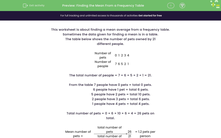What is frequency?

In physics, you might have heard of the frequency of sound.
In maths, frequency is much simpler - it's just the number of times something occurs!
For example, below we have the frequency table made from responses to a survey on the number of pets owned:
| Number of pets | 0 | 1 | 2 | 3 | 4 |
| Frequency | 7 | 6 | 5 | 2 | 1 |
We can see that 0 pets has the frequency of 7, so 7 people responded with '0 pets owned'.
We can find the mean from a frequency table just as we do if we have the data points in a list:
mean = sum of all data points ÷ number of data points
The total number of people here, i.e. the number of data points, is all the frequencies added together:
7 + 6 + 5 + 2 + 1 = 21
From the table, we have:
7 people have 0 pets which is a total of 7 x 0 = 0 pets
6 people have 1 pet which is a total of 6 x 1 = 6 pets
5 people have 2 pets which is a total of 5 x 2 = 10 pets
2 people have 3 pets which is a total of 2 x 3 = 6 pets
1 person has 4 pets which is a total of 1 x 4 = 4 pets
So altogether, we get the total number of pets, i.e sum of all data points, is:
0 + 6 + 10 + 6 + 4 = 26 pets

Mean number of pets = the total number of pets ÷ the total number of people
The mean number of pets is 26 ÷ 21 = 1.2 pets per person.
Ready to grab your calculator and put this into practice?








